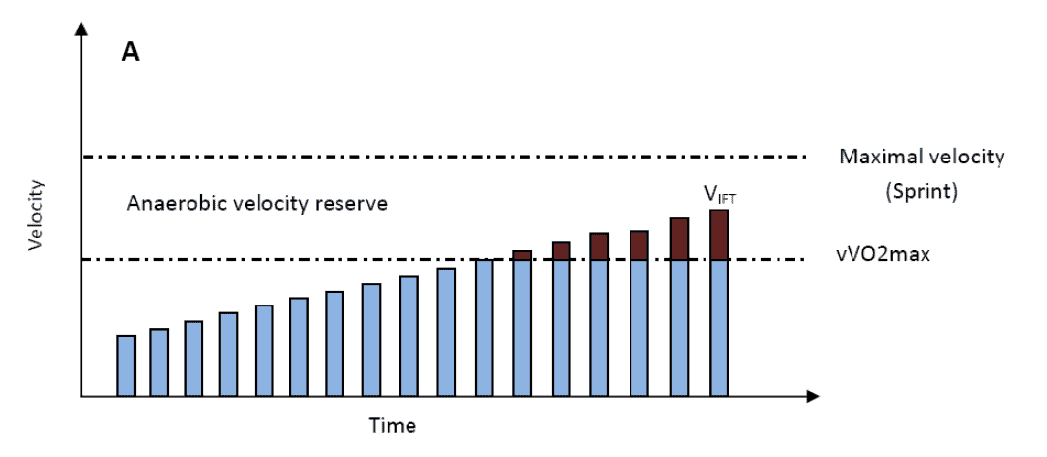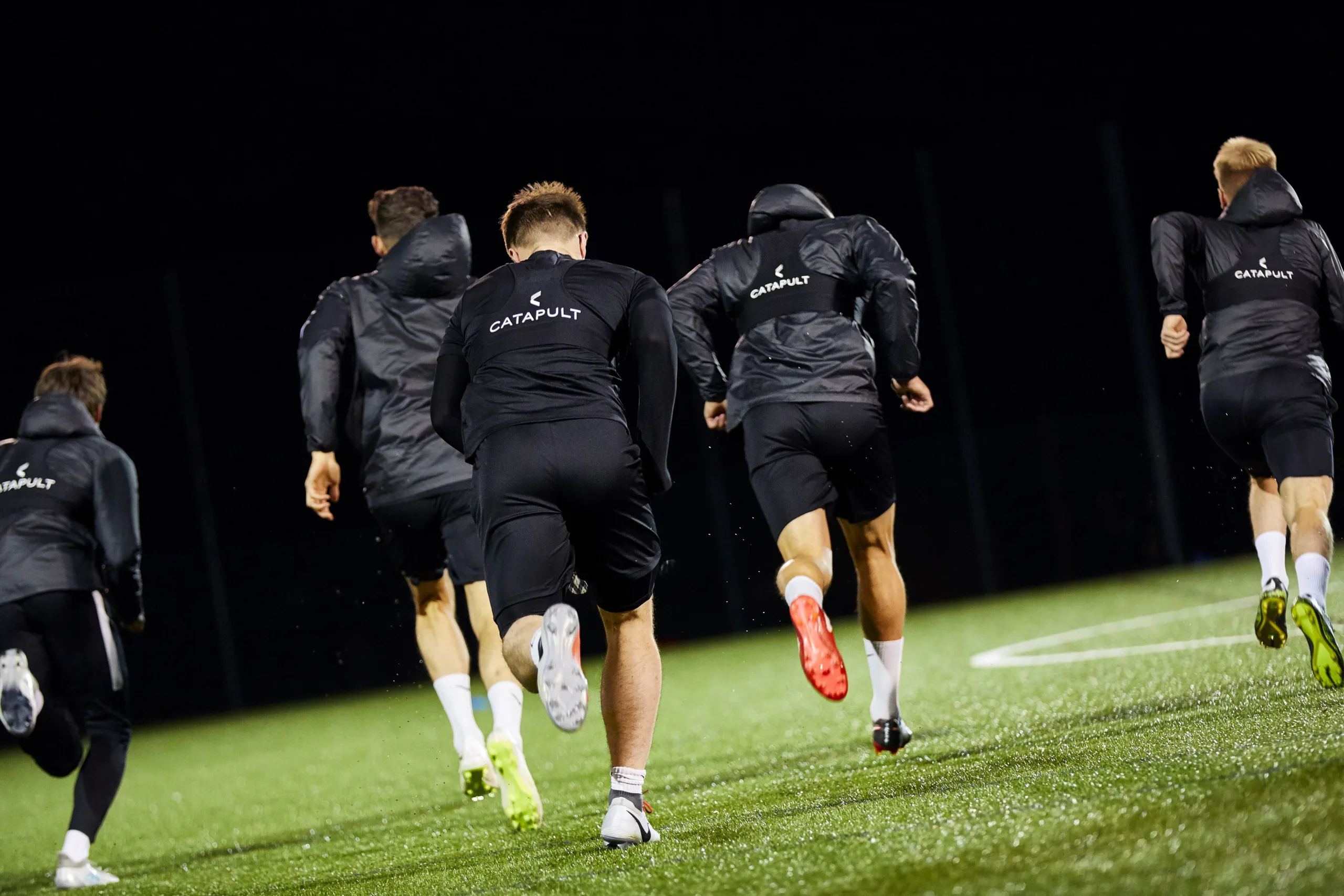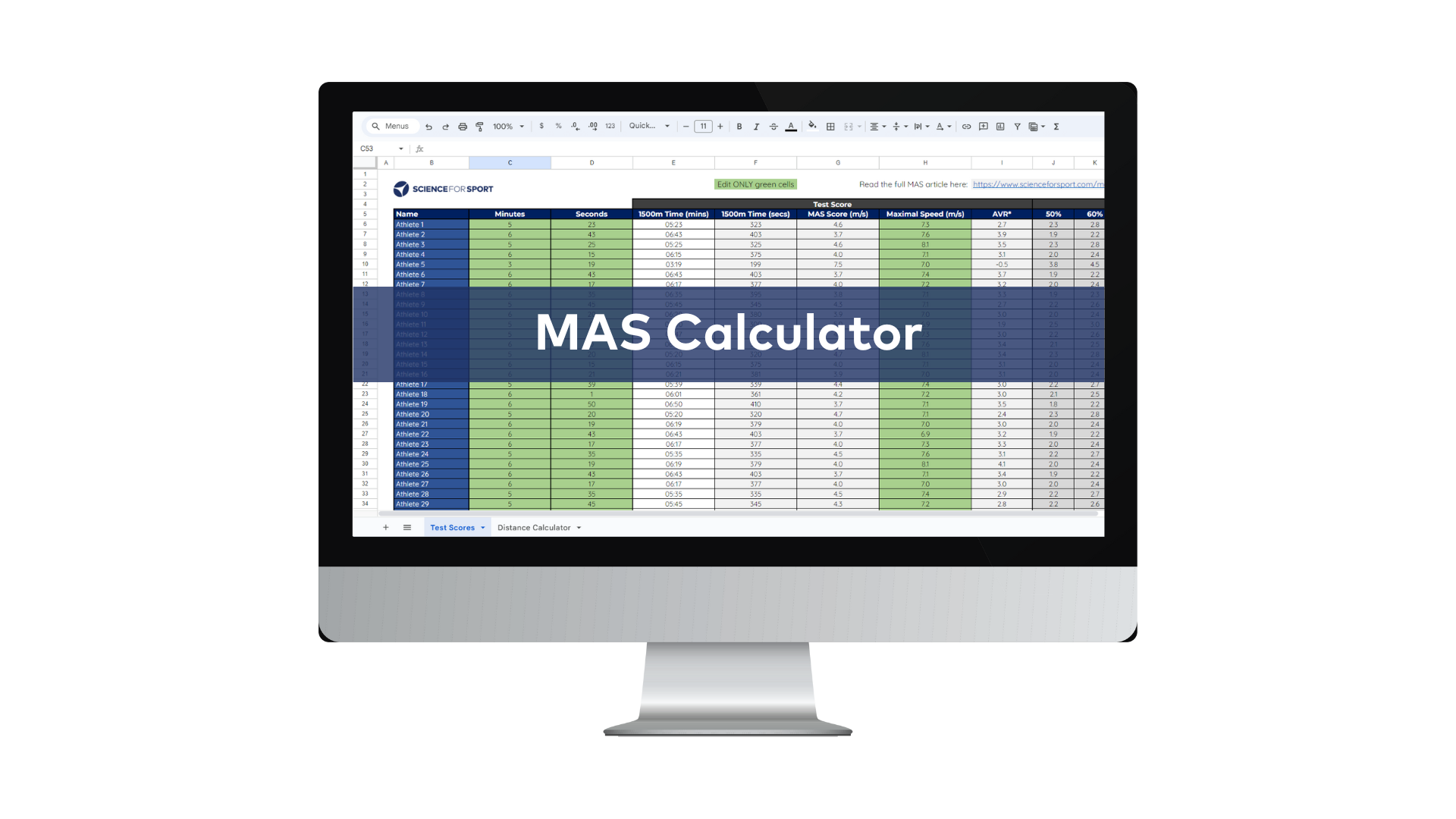Contents of Article
- Summary
- What is maximal aerobic speed?
- Why is maximal aerobic speed useful for sports?
- How do you test maximal aerobic speed?
- How do you calculate maximal aerobic speed?
- Examples of maximal aerobic speed scores
- Conclusion
- References
- About the Author
Summary
Maximal aerobic speed (MAS) is simply the lowest running speed at which maximum oxygen uptake (VO2 max) occurs, and is typically referred to as the velocity at VO2 max (vVO2 max). MAS was developed for the purpose of increasing the specificity of training and to enable coaches to monitor training loads more accurately.
There are many tests which can be used to measure an athlete’s MAS, but for many, “corrective” equations must be used to accurately determine their MAS. Coaches need to understand the differences between these common aerobic tests and the corrective equations if they are to accurately measure MAS and prescribe training based on this information.
What is maximal aerobic speed?
Maximal aerobic speed (MAS) is simply the minimal running velocity at which VO2 max occurs – otherwise known as the ‘velocity at VO2 max’ (vVO2 max) (1). In other words, it is the lowest speed at which maximum oxygen uptake (VO2 max) occurs (2, 3). For example, once an athlete reaches their VO2 max, although they may still be able to run faster, their VO2 max will not increase any higher. Because of that, MAS is therefore the ‘slowest’ speed at which an athlete reaches their VO2 max (4).
Figure 1 displays an athlete achieving MAS during an incremental VO2 max test. As a result, MAS is directly related to VO2 max but not running economy (4).

Figure 1 – Maximal aerobic speed (vVO2 max) and the anaerobic velocity reserve (5)
As it was understood that VO2 max is not a useful measure for setting running paces and durations for training, MAS was developed to help coaches understand the physical demands of their training prescription (1). It also allows coaches to be more specific with their training prescription and volume-load monitoring as they can prescribe specific speeds (4.4 m/s).
Also displayed in Figure 1, is the anaerobic velocity reserve, or what is otherwise referred to as the anaerobic speed reserve. The anaerobic velocity reserve is measured in metres per second (m/s) and is simply the speed difference between maximal aerobic speed and maximal sprint speed (5).
For example:
Athlete A has the following:
- Maximal Aerobic Speed = 5.0 m/s
- Maximal Sprint Speed = 10.0 m/s
- Anaerobic Velocity Reserve = 5.0 m/s
Athlete B has the following:
- Maximal Aerobic Speed = 4.6 m/s
- Maximal Sprint Speed = 9.8 m/s
- Anaerobic Velocity Reserve = 5.2 m/s
Why is maximal aerobic speed useful for sports?
As many field sports are very aerobic in nature and require athletes to perform at high intensities throughout the duration of the game, it would appear almost obvious that high aerobic power is an important aspect of their performance. A recent review has shown that higher-level endurance athletes possess a larger aerobic power than lower-level athletes, but it is important to understand that this did not necessarily mean they were able to perform better (6).
To add to this, it appears the greater the running demands of the sport, the greater the MAS required for athletes in that sport to compete, especially at the highest level (7).
For example, female football players have been shown to maintain an average heart rate of 84-86 % of their maximum, and travel 9.1-11.9 km during a 90-minute match (8). These athletes have demonstrated a good level of aerobic power (VO2 max: 46–57.6 mL·kg–1·min–1) (9, 10, 11), and those with a larger aerobic power have also been shown to perform better during a game (9, 10, 12).
Something to consider, however, is these “improved” performances were measured by increased distance covered, enhanced work intensity, and a higher number of sprints and involvements with the ball during a match (9) – but do all of these actually mean better performances? Nevertheless, these are all important qualities and the strength and conditioning coach/sports scientist must decide for themselves whether it is worthwhile improving their athlete’s aerobic ability. Therefore, they need to decide whether improving it will give them the “edge” they need to perform better, or not.
How do you test maximal aerobic speed?
Whilst many different tests have been used to measure an athlete’s MAS, it is important to understand that not all tests will produce the same result; meaning accurately measuring MAS can be difficult.
Recall the definition of MAS: it is the lowest speed at which VO2 max occurs. As some athletes can continue to run, and even run faster, despite already achieving their VO2 max, many tests may cloud the athlete’s true MAS. As a result, we will help to provide a degree of clarity to this issue by discussing some of the common problems.
First and foremost, for running-based field sport athletes, it is highly recommended that MAS is assessed during running-based tests. Over the years many running-based MAS tests have been developed, so picking the right one can be a difficult decision when the practitioner is uninformed of the strengths and weaknesses of each test. Table 1 provides a breakdown of some of the common tests and their structure.
Table 1. Tests used to measure and athlete’s MAS (from Baker and Heaney, 2015 (7)).

As can be seen in Table 1, there are many different tests used to measure MAS, and each of these tests is different in nature. Some involve linear running, others involve shuttle-based running, some are continuous, others are incremental, and some are steady-paced, whilst others are timed. It is absolutely vital the sports scientist or strength and conditioning coach understands the difference between these tests in terms of their nature.
As shuttle-based tests include constant deceleration, change of direction and acceleration, these “high-intensity” actions add an anaerobic element to the test that is typically not present during continuous, linear running tests. This results in the aerobic system working harder to replenish the anaerobic stores used for these “high-intensity” actions. For example, it is well-known that change of direction performance is an important factor concerning an athlete’s performance during the 30-15 intermittent fitness test (23, 24, 5). It is therefore understood that shuttle-based tests result in lower and inaccurate MAS scores, if not corrected for (1, 7).
How do you calculate maximal aerobic speed?
To account for the aforementioned issues when using shuttle-based tests to calculate MAS, “corrective” equations have been developed for certain tests. Tests without their own specific corrective equation can use a simple generic formula.
Multistage Fitness Test – Corrective Equation (1)
MAS (km/h) = Final Shuttle Speed (km/h) * 1.34 – 2.86
1200m Shuttle Test
Equation for athletes with a heavy body mass (approx. 100 kg) (7)
MAS (m/s) = 1200 / (time in seconds – 29)
Equation for athletes with a light body mass (7)
MAS (m/s) = 1200 / (time in seconds – 20.3)
Generic “corrective” Equation
For other tests, a generic “corrective” calculation is typically used (25):
MAS (m/s) = Estimated VO2 max / 3.5
Examples of maximal aerobic speed scores
Table 2 provides some clear examples of the MAS scores of elite-level athletes from a variety of different sports.
Table 2. Comparison of MAS scores between elite-level athletes from various sports (from Baker and Heaney, 2015 (7)).

Conclusion
Maximal aerobic speed, otherwise known as MAS, is a useful tool for measuring performance, training prescription, and monitoring training loads. Finding the most effective and time-orientated methods for developing an athlete’s aerobic power is of great importance, and training prescription based on MAS may facilitate these types of improvements.
However, it is important the practitioner fully understands the complications with measuring MAS when using various tests.
- Berthoin, S., Gerbeaux, M., Geurruin, F., Lensel-Corbeil, G., and Vandendorpe, F. Estimation of maximal aerobic speed. Science & Sport, 7(2): 85-91. 1992. [Link]
- Rampinini, E, Impellizzeri, FM, Castagna, C, Coutts, A, and Wisloff, U. (2009). Technical performance during soccer matches of the Italian Sere A league: Effect of fatigue and competitive level. Journal of Science & Medicine in Sport, 12: 227–233. [Link]
- Bosquet, L., Léger, L. and Legros, P. (2002). Methods to Determine Aerobic Endurance. Sports Medicine, 32 (11): 675-700. [Link]
- Berthoin, S., Baquet, G., Manteca, F., Lensel, G., Gerbeaux, M. (1996). Maximal Aerobic Speed and Running Time to Exhaustion for Children 6 to 17 Years Old. Paediatric Exercise Science, 8(3): 234 – 244. [Link]
- Buchheit, M. (2010). The 30-15 intermittent fitness test – 10-year review. [Link]
- Lorenz, D.S., Remian, D.P., Naylor, A. (2013). What performance characteristics determine elite versus nonelite athletes in the same sport? Sports Health, 5(6):542-7. [Link]
- Baker, D.G., & Heaney, N. (2015). Normative data for maximal aerobic speed for field sport athletes: A brief review. Journal of Australian Strength and Conditioning. 23(7): 60-67. [Link]
- Turner, E., Munro, A.G., and Comfort, P. (2013). Female soccer: Part 1 – a needs analysis. Strength and Conditioning Journal, 35 (1) , 51-57. [Link]
- Helgerud, J., Engen, L.C., Wisloff, U., and Hoff, J. (2001). Aerobic endurance training improves soccer performance. Med Sci Sports Exerc 33: 1925–1931. [Link]
- McMillan, K., Helgerud, J., Macdonald, R., and Hoff, J. (2005). Physiological adaptations to soccer specific endurance training in professional youth soccer players. Br J Sports Med, 39: 273–277. [Link]
- Wong, P.L., Chamari, K., and Wisloff, U. (2009). Effects of 12-week on-field combined strength and power training on physical performance among U-14 young soccer players. J Strength Cond Res 24: 644– 652. [Link]
- Hoff, J., Wisloff, U., Engen, L.C., Kemi, O.J., and Helgerud, J. (2002). Soccer specific aerobic endurance training. Br J Sports Med, 36: 218–221. [Link]
- Leger, L., and Boucher, R. (1980). An indirect continuous running multistage field test: the ‘‘Universite ́ de Montre ́al’’ Track Test. Canadian Journal of Applied Sports Sciences, 5: 77–84. [Link]
- Léger, L.A., Mercier, D., Gadoury, C., and J. Lambert. (1988). The multistage 20-metre shuttle run test for aerobic fitness. Journal of Sports Sciences, 6 (2): 93–101. [Link]
- Bangsbo, J., Iaia, M., and Krustrup, P. (2008). The Yo-Yo Intermittent Recovery Test: A Useful Tool for Evaluation of Physical Performance in Intermittent Sports. Sports Medicine, 38(1):1-16. [Link]
- Cazorla, G. (1990). Field tests to evaluate aerobic capacity and maximal aerobic speed. Proceedings of the International Symposium of Guadeloupe, 151–173. [Link]
- Carminatti, L., Possamai, C., de Moraes, M., da Silva, de Lucas, J., Dittrich, N., and L. Guglielmo. (2013). Intermittent versus continuous incremental field tests: are maximal variables interchangeable? Journal of Sports Science and Medicine. 12: 165 – 170. [Link]
- Kelly, V., Jackson, E., and Wood, A. (2014). Typical scores from the 1.2km shuttle run test to determine maximal aerobic speed. Journal of Australian Strength & Conditioning. 22(5):20-23. [Link]
- Berthon, P., Fellmann, N., Bedu, M., Beaune, B., Michel Dabonneville, M., Jean Coudert, J. and Chamoux, A. (1997). A 5-min running field test as a measurement of maximal aerobic velocity. European Journal of Applied Physiology. 75: 233–238. [Link]
- Chamoux, A., Berthon, P., and Laubignat, J.F. (1996). Determination of maximum aerobic velocity by a 5-minute test with reference to world running records. A theoretical approach. Archives of International Physiology & Biochemistry. 104:207–211. [Link]
- Gallo, T., Cormack, S., Gabbett, T., Morgan, W., and Lorenzen, C. (2014). Characteristics impacting on session rating of perceived exertion training load in Australian footballers. Journal of Sports Sciences. 33(5):467-475. [Link]
- Lorenzen, H. D., Williams, M. D., Turk, P. S., Meehan, D. L., & Cicioni-Kolsky, D. J. Relationship between velocity reached at VO2max and time-trial performance in elite Australian rules footballers. International Journal of Sports Physiology & Performance. 4:408-411. [Link]
- Haydar, B., Al Haddad, H., Ahmaidi, S., and Buchheit, M. (2011). Assessing inter-effort recovery and change of direction ability with the 30-15 Intermittent Fitness Test. Journal of Sports Science & Medicine, 10(2):346-354. [Link]
- Buchheit, M. (2008). The 30-15 Intermittent Fitness Test: accuracy for individualizing interval training of young intermittent sport players. J Strength Cond Res 22: 365-374. [Link]
- Léger, L., and Mercier, D. (1984). Gross energy cost of horizontal treadmill and track running. Sports Medicine. 1 (4): 270–277. [Link]
- Rampinini, E., Bishop, D., Marcora, S.M., Ferrari Bravo, D., Sassi, R., and Impellizzeri, F.M. (2007). Validity of simple field tests as indicators of match-related physical performance in top-level professional soccer players. International Journal of Sports Medicine. 28: 228–235. [Link]
- Gabbett, T. (2013). Influence of playing standard on the physical demands of professional rugby league. Journal of Sports Sciences. 31(10): 1125–1138. 2013. [Link]
- Stephens, P. (2004). Fitness evaluation of Gaelic football players. Masters’ Thesis, submitted, Dublin City University. [Link]
- Jennings, D.H., Cormack, S.J., Coutts, A.J., and Aughey, R.J. (2012) International field hockey players perform more high-speed running than national-level counterparts. Journal of Strength & Conditioning Research, 26(4): 947–952. [Link]
- Billatt, V., Faina, M., Sardella, F., Marini, C., Fanton, F., Lupo, B., Faccini, P., De Angelis, M., Koralsztein, J. and A. Dalmote. (1996). A comparison of the time to exhaustion at VO2max in elite cyclists, kayak paddlers, swimmers and runners. Ergonomics. 39(2):267- 277. [Link]
- Boullosa, D.A., Tuimil, J.L., Leicht, A.S., and Crespo-Salgado, J.J. (2009). Parasympathetic modulation and running performance in distance runners. Journal of Strength & Conditioning Research. 23(2): 626–631. [Link]




